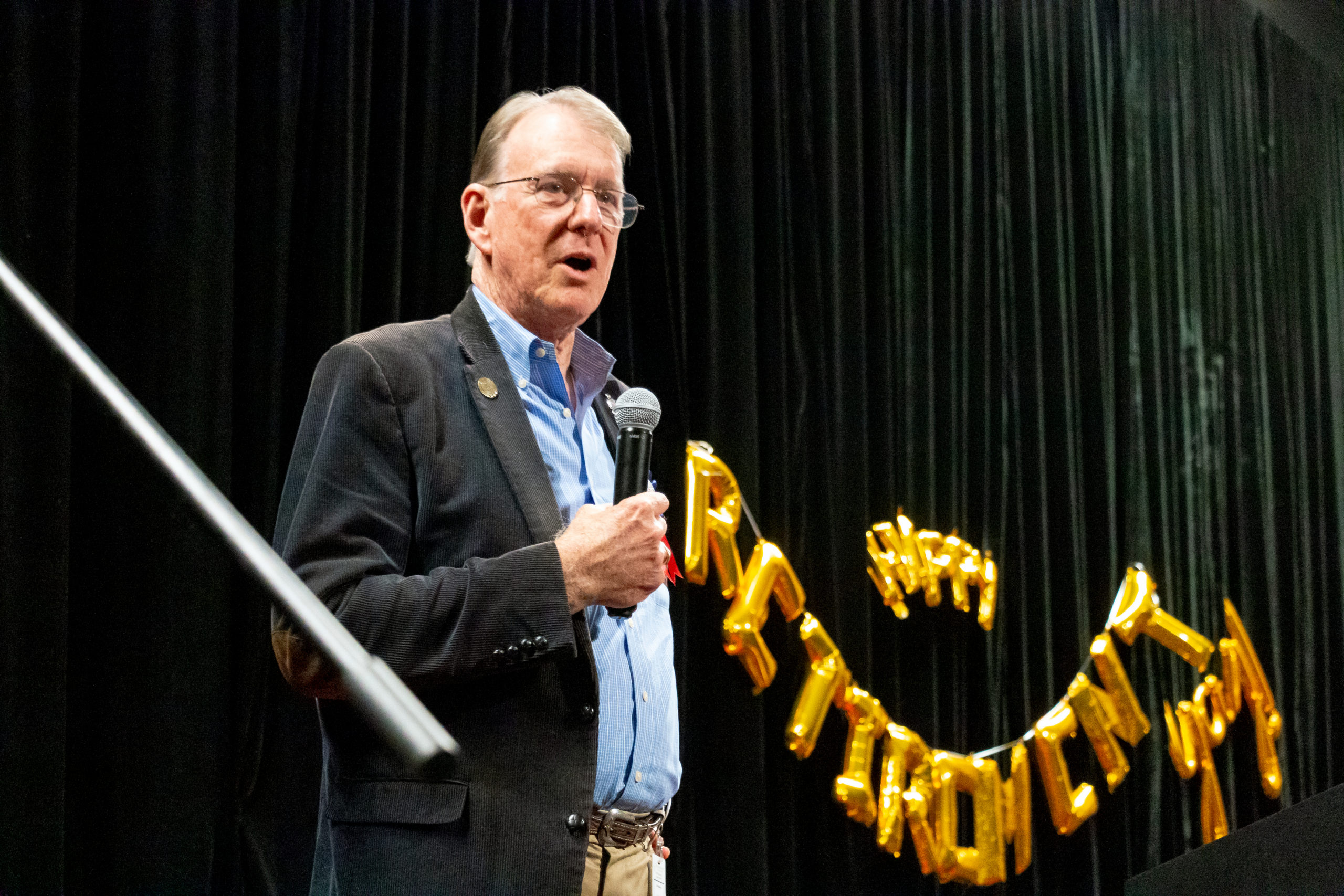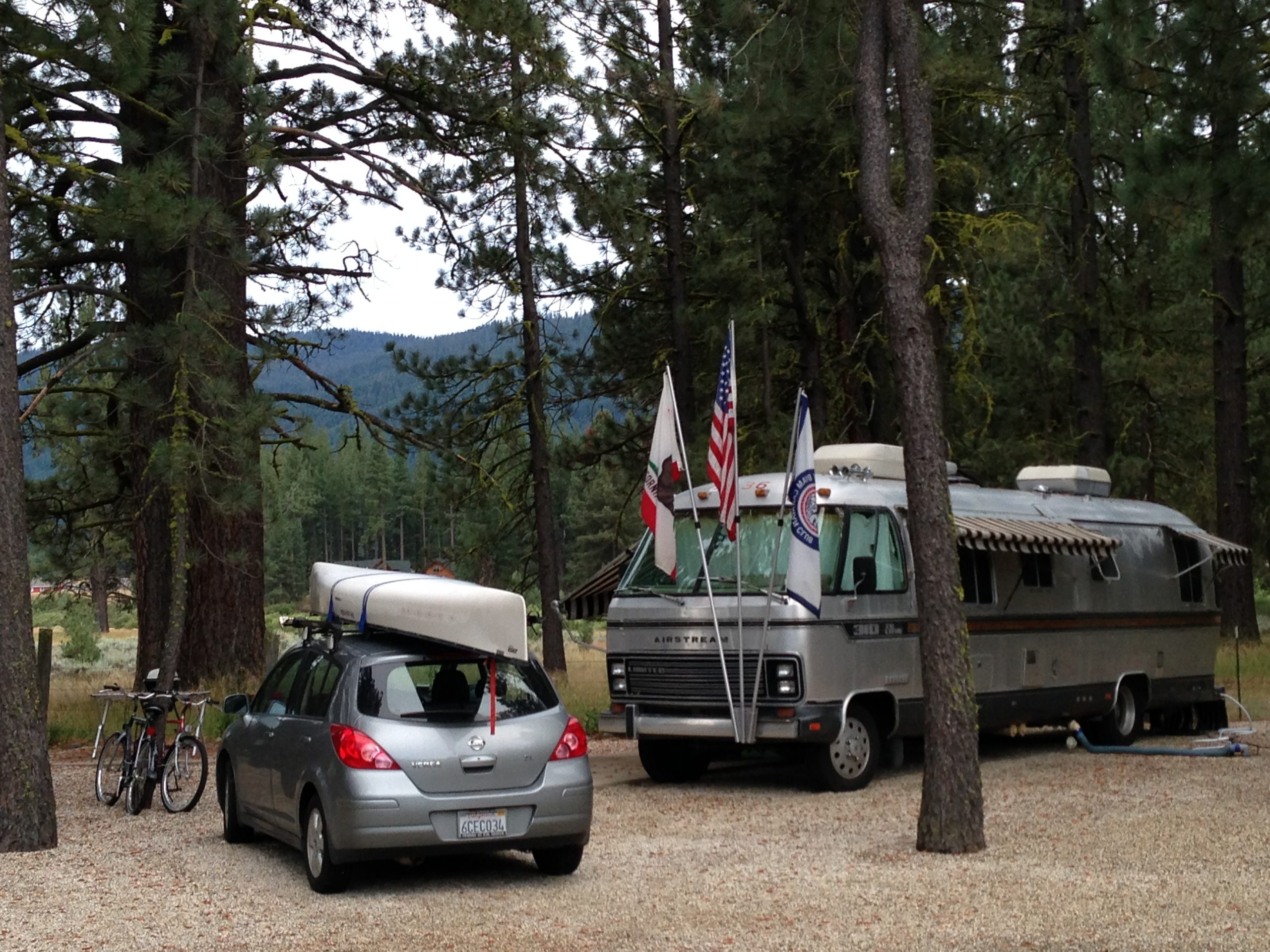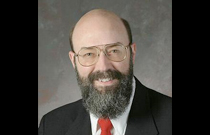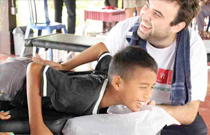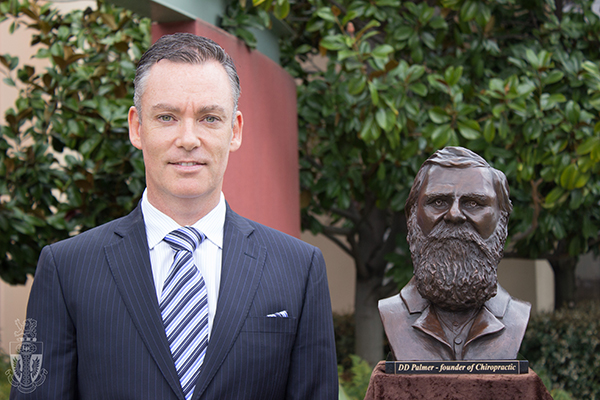Dr. Jim Hawkins has been there for every step as Life Chiropractic College West grew up. Nearly 40 years later, it’s early November and he’s teaching his last anatomy class.
He’s looking ahead, somewhat reluctantly, to December when he plans to retire. He wants Life West to be able to carry on his work seamlessly.
He’s also trying to avoid looking ahead, because he can’t imagine not being on the Hayward, California, campus and walking the corrugated metal halls of Life West during the week.
Every student who started as a freshman at Life West has had Dr. Hawkins for an anatomy class. Many of the students who transferred to Life West have also taken his class. His list of alumni contacts (Life West has 5,000 graduates) is unrivaled by anyone on campus.

Dr. Jim Hawkins speaks at a recent graduation ceremony. He’s been at all of them, except for one in 1987.
He’s been to 73 graduation ceremonies–all but one, which he missed in 1987 for a training seminar that he was helping to run, and he will be attending graduation ceremonies for the next several years as his current students work their way through their degree.
“I will be at their graduation – I make that commitment to every student,” Dr. Hawkins said.
Early days in the classroom
Dr. Hawkins had no experience with chiropractic philosophy when he got a call about teaching anatomy in the mid-1970s. He was teaching anatomy at several different colleges in the Bay Area – “I was doing it as an itinerant–an educational braceros”–when he got the call from what was then the Pacific States Chiropractic College.
Falling into the unknown wasn’t new for Dr. Hawkins. He studied general biology as an undergraduate at San Francisco State University, then spent a couple of years in the Peace Corps in Africa where he gathered data on bats and the parasites they were carrying for his master’s degree thesis on parasitology. While there, he also taught biology at a high school in Kenya.
Back in the U.S. and now an older student in graduate school at SFSU, he hit it off with a professor in the anatomy department who had a connection with Africa.
“I ended up teaching anatomy labs at San Francisco State, and I would go to his lab every class, then teach what he taught” to different students in his own class, Dr. Hawkins said. Eventually, he was teaching those lessons at schools around the bay.
Although he wasn’t set on a career at that time–he was also running S.F. State’s field camp in the Sierra, where students could and still can take biology courses in a remote setting–he was happy to get the call from the chiropractic college in the East Bay. Newly married, Dr. Hawkins was taken by surprise when he met his first students.

Dr. Hawkins will continue to be a fixture at Life West graduation ceremonies. He still has several students going through the program, and he’s promised all of them that he’ll be there when they graduate.
“I discovered a really different place and way to teach,” he said. “They were really interested in my subject. In community colleges, anatomy was a requirement for something else and their level of interest … varied. But the chiropractic students really wanted to know, and that was very refreshing.”
Finding his purpose
Dr. Hawkins was offered a full-time position after his first quarter teaching, and he accepted “even though the pay was modest.”
Those were lean times.
In 1979, Pacific States Chiropractic College was a struggling new school founded by Dr. George Anderson and Dr. George Wentland. Students had just begun to attend classes in the months before. There weren’t a lot of resources. The college rented space. One day after a break, the money for paychecks didn’t get deposited.
The founders asked the handful of teachers to take a pay cut, promising to pay them with interest once they got through the storm.
“We all shrugged our shoulders and realized the alternative was for the college to fold,” Dr. Hawkins said. “We stuck in there, and 9 months later, Life College and Dr. Sid Williams came through with a proposal. The board of Pacific States Chiropractic College agreed to have it become Life West and got seed money to keep going.” Not only did Dr. Williams come through with his promise, he gave a raise to the teachers as well. Dr. Gerald Clum came from Life Chiropractic College in Georgia to lead the school, and Clum remained president of Life West for 30 years until 2010.
“All that struggle was part of what made Life West what it is today,” Dr. Hawkins said. “It really knit us together as a community. We were forced to stick together. The key thing for me was that in addition to finding out it was fun to teach, I also found that the philosophy of health that chiropractic espouses was an articulation of my own philosophy.”
“I really embrace it all, and it’s been an incredible experience.”
In the early 1980s, Dr. Hawkins enrolled in Life West’s chiropractic program with plans to become a chiropractor. He even taught some of the basic science courses that he needed. “If you want to learn something, teach it to someone else,” he said. He got far enough along in the program that there came a point when he would need to become a full-time student and stop teaching. “I had a crisis moment and decided I couldn’t leave the classroom, so I decided not to pursue a chiropractic degree,” he said. “But I have a strong connection with chiropractic. The college granted me an honorary degree in 1992, and I wear a doctoral gown when I go to graduation.”
Celebrating a diverse community
Dr. Hawkins says he’s always been impressed with the inclusive nature of the Life West community. “We’ve always been able to embrace a wide variety of diversity, on any level you want to talk about,” he said. In chiropractic, for example, there are many different strategies or techniques a chiropractor can use in practice. “We have people who come into our program who are already committed to one or another perspective, and what they find is they learn to respect the other perspectives. I think that’s beneficial for everyone.”
His own personal philosophy of health centers on community: “Community occurs on a whole bunch of different levels,” he said. “Our diversity and focus on celebrating our perspectives creates a platform where we can authentically communicate. It’s universally demonstrated that once you get to know someone, you no longer see them in same way.”
He feels a deep sense of community at Life West.
“You can’t walk around the halls of Life West, not as a stranger, and not have people come up to you and ask if they can help. The other thing is that you seldom see people at Life West who are unwilling to make eye contact. That’s one of my measures of people who are comfortable–if you are willing to make eye contact. That’s an important part of what creates a community, when people are willing to literally see each other. We can disagree pretty vehemently but still respect each other and not label each other with some kind of artificial label. I think that’s a really great part of the Life West culture.”
[quote align=”center” color=”#999999″]Help Dr. Jim Hawkins reach his quest of enrolling 40 new members in the President’s Circle. See how you can join online.[/quote]
That sense of authentic connection also occurs in Dr. Hawkins’ storytelling teaching style. “That’s something I pride myself on, sharing my stories and encouraging others to share theirs. Over the years, students have referred to my stories as Hawk Talks. Sometimes on the subject matter, of course, but also on life in general or some theme that comes out of the subject matter of the class and how it applies to my life.”
What’s next?
Dr. Hawkins says he wants to do some writing after he retires, maybe about his experiences in Africa or the different chapters of his life.
He’s always enjoyed visiting the offices of Life West graduates, and he thinks he’ll combine that with his love of travel. He and his wife have a 1984 vintage Airstream motorhome which he’d like to spruce up and take on the road. “I mentioned in only half-jest that if the college wants to put a banner on it, I could advertise Life West” while traveling the country, he said.
In a recent Hawk Talk in Life Styles, the Life West alumni magazine, he said that becoming an alumni ambassador and traveling to former students around the world was a dream of his. “It is truly a privilege to see our chiropractors in action,” he wrote.
There are also some volunteer plans in the works–with Habitat for Humanity, maybe the local library. He also says he’ll start walking with a group in his Sacramento community that does 5-6 miles three days a week.
Dr. Hawkins will continue to encourage Life West students, just from a little further away.
“I firmly believe that each of us has a purpose, and that purpose is not something we invent,” he said. “It’s something that’s in us and it’s something that we can explore in ourselves and bring out. When we do, and live our life through that purpose, we get the highest possible level of personal fulfillment, joy, happiness.”
“That’s been the thing that I’ve been trying to express in terms of how Life West has worked for me. It fit right square in the middle of my personal purpose.”
In another recent Hawk Talk, Dr. Hawkins told readers, “My life’s purpose has been to attempt to flood the world with chiropractors–not just doctors of chiropractic, but passionate human beings who find fulfillment in serving others.”
There can be no doubt that he’s done that.


